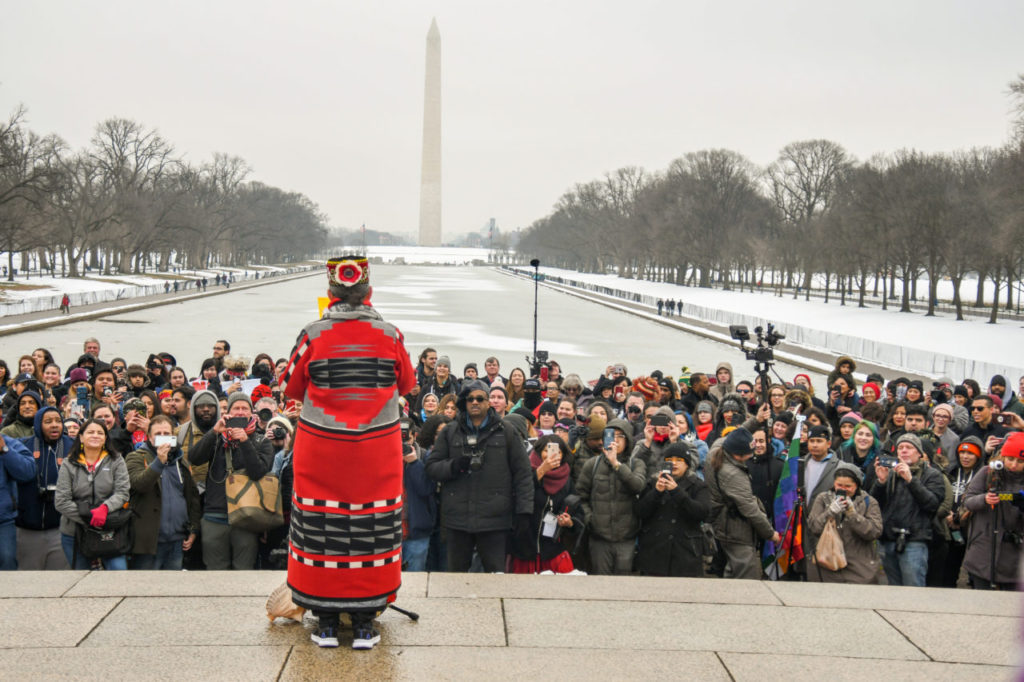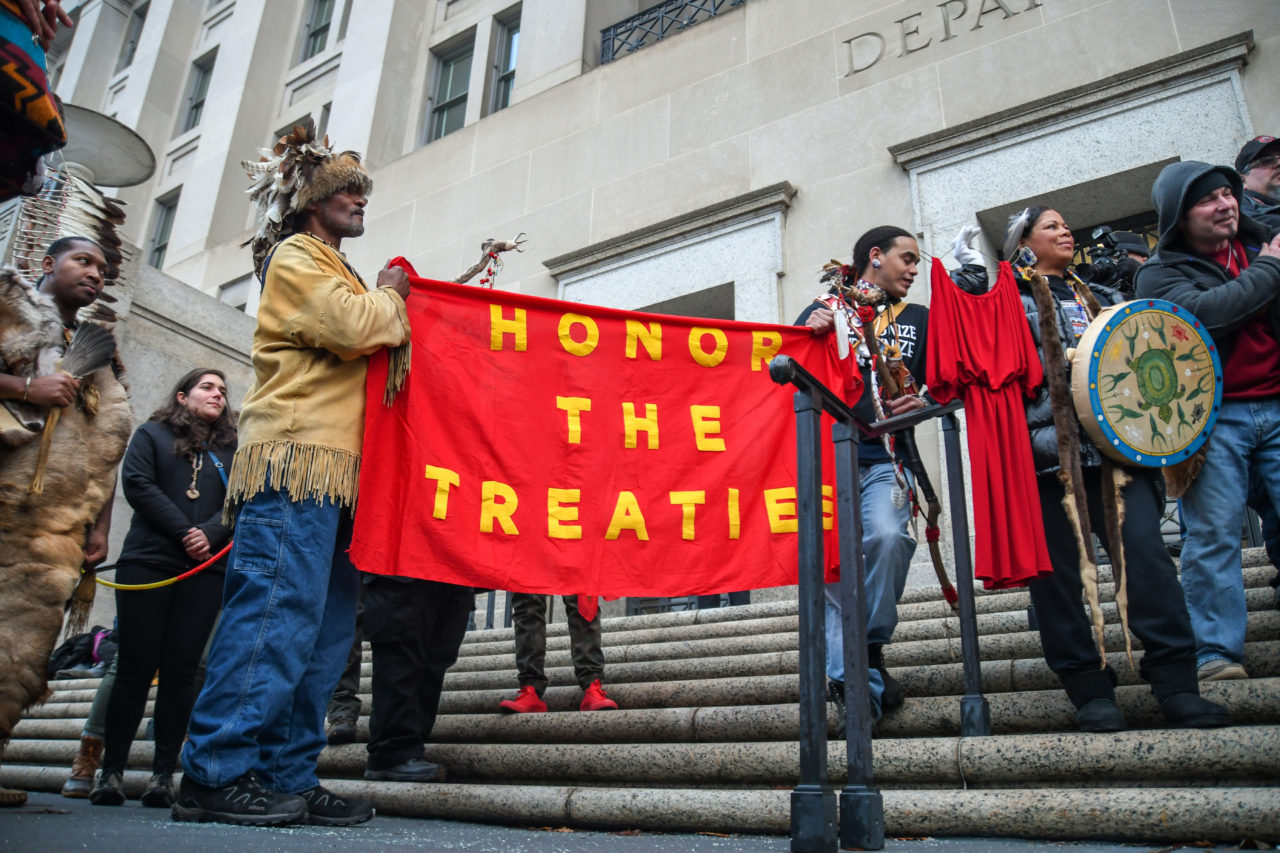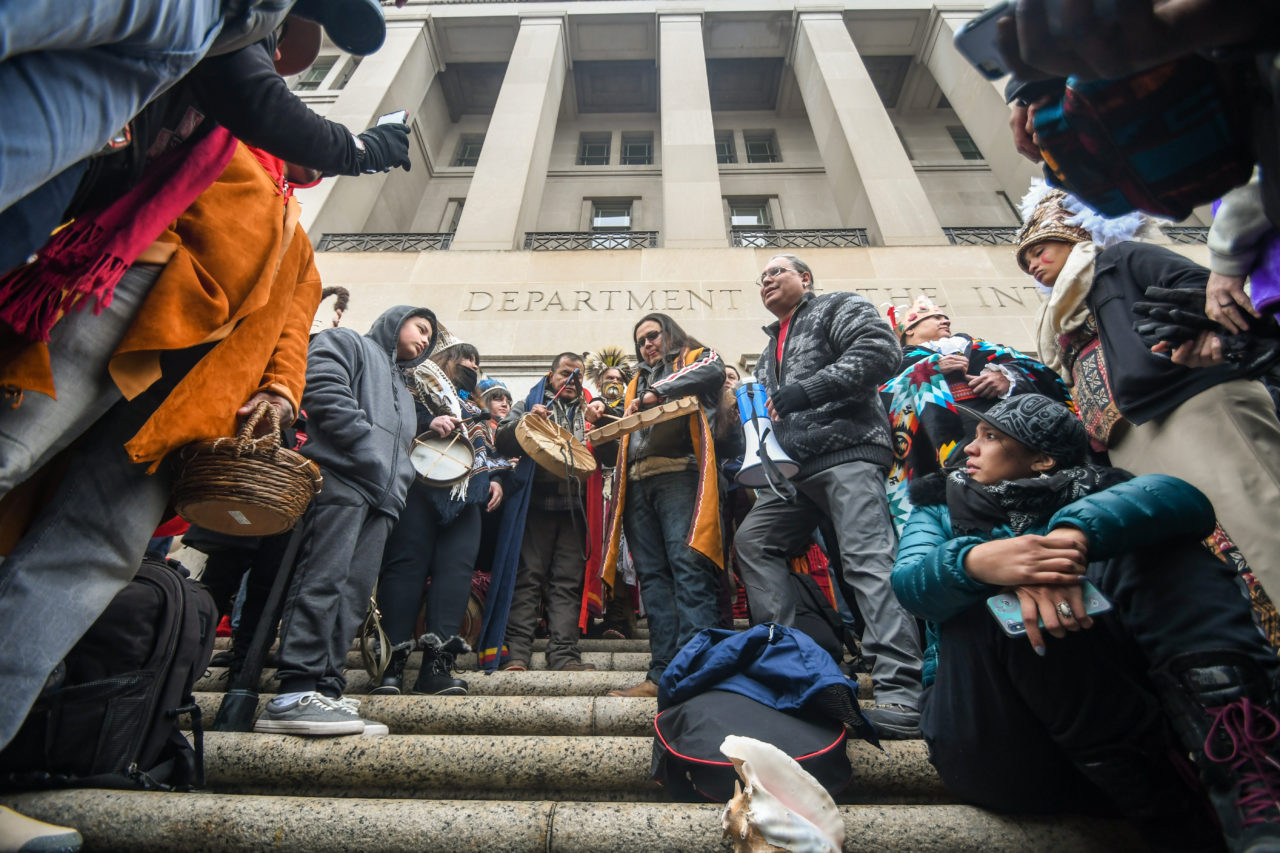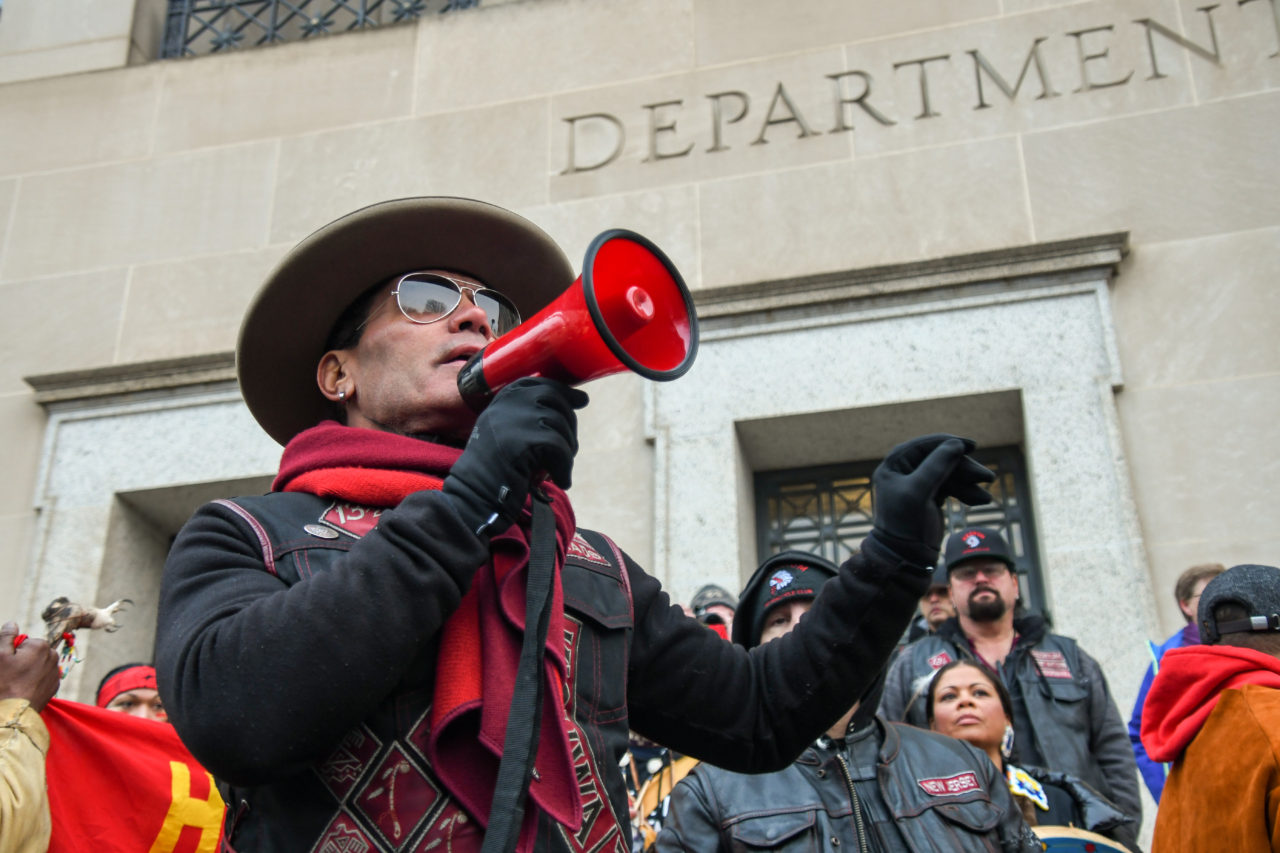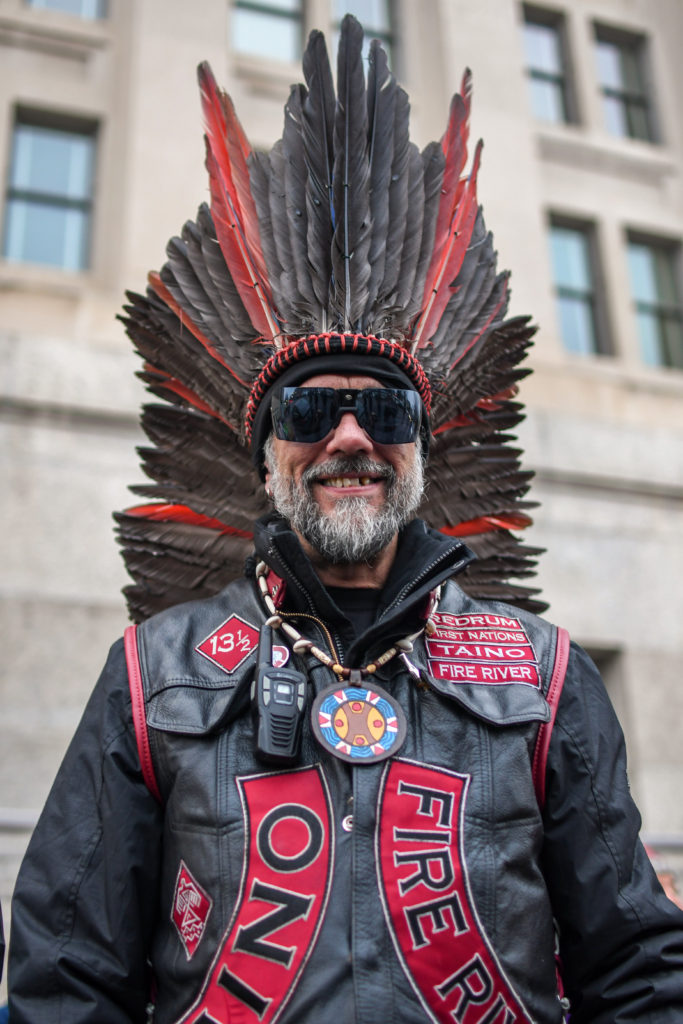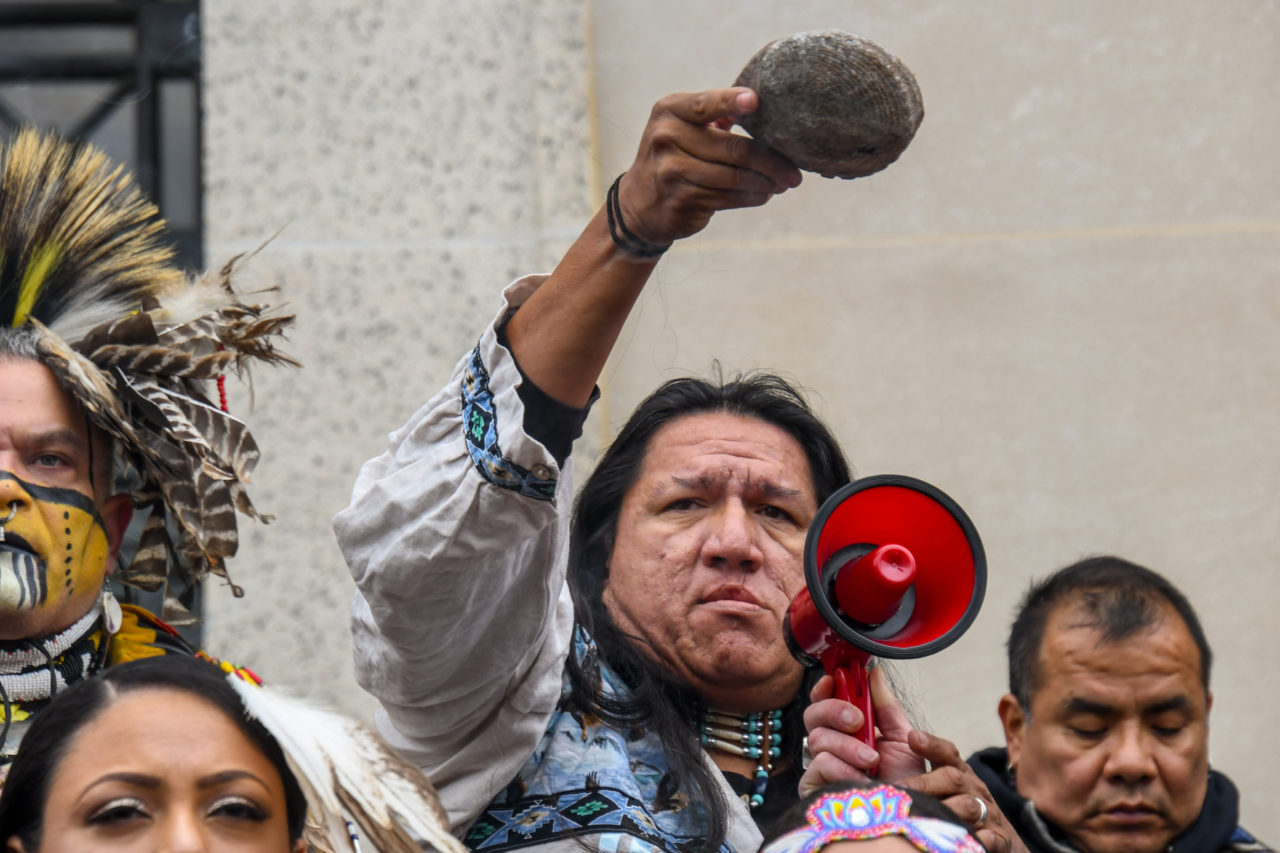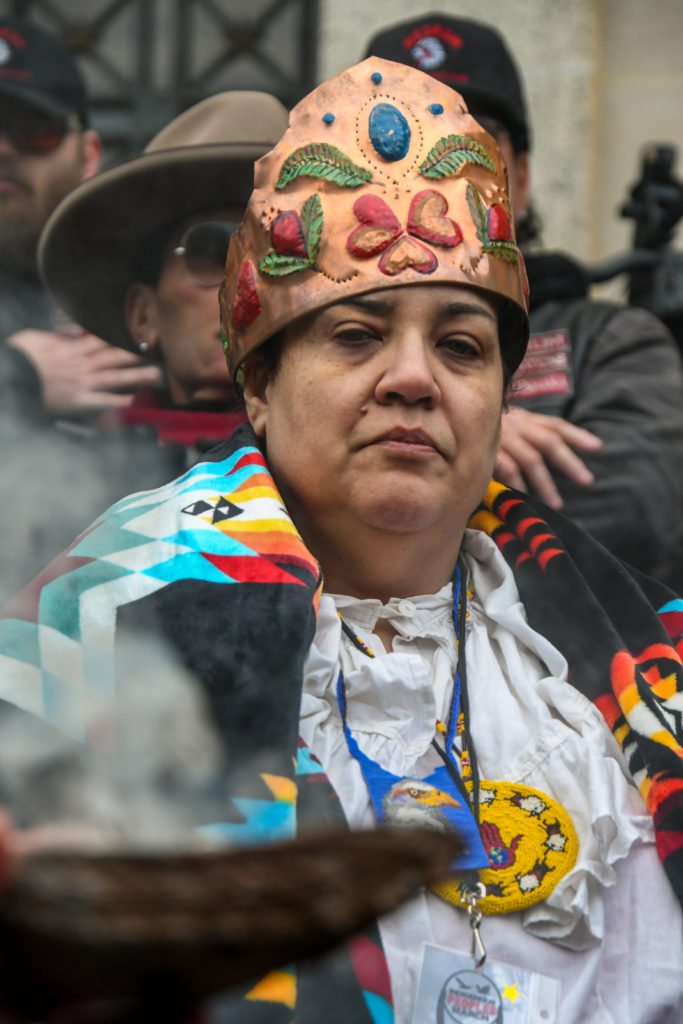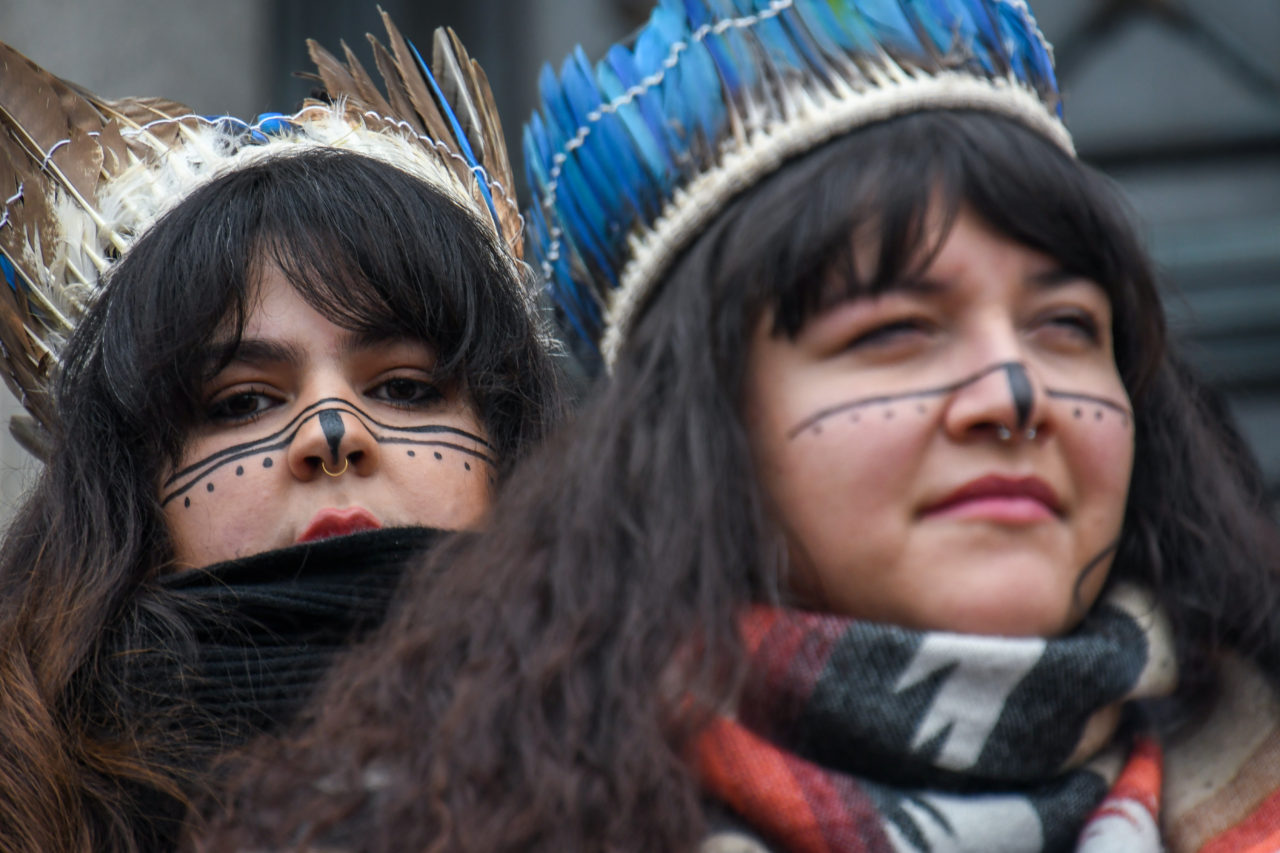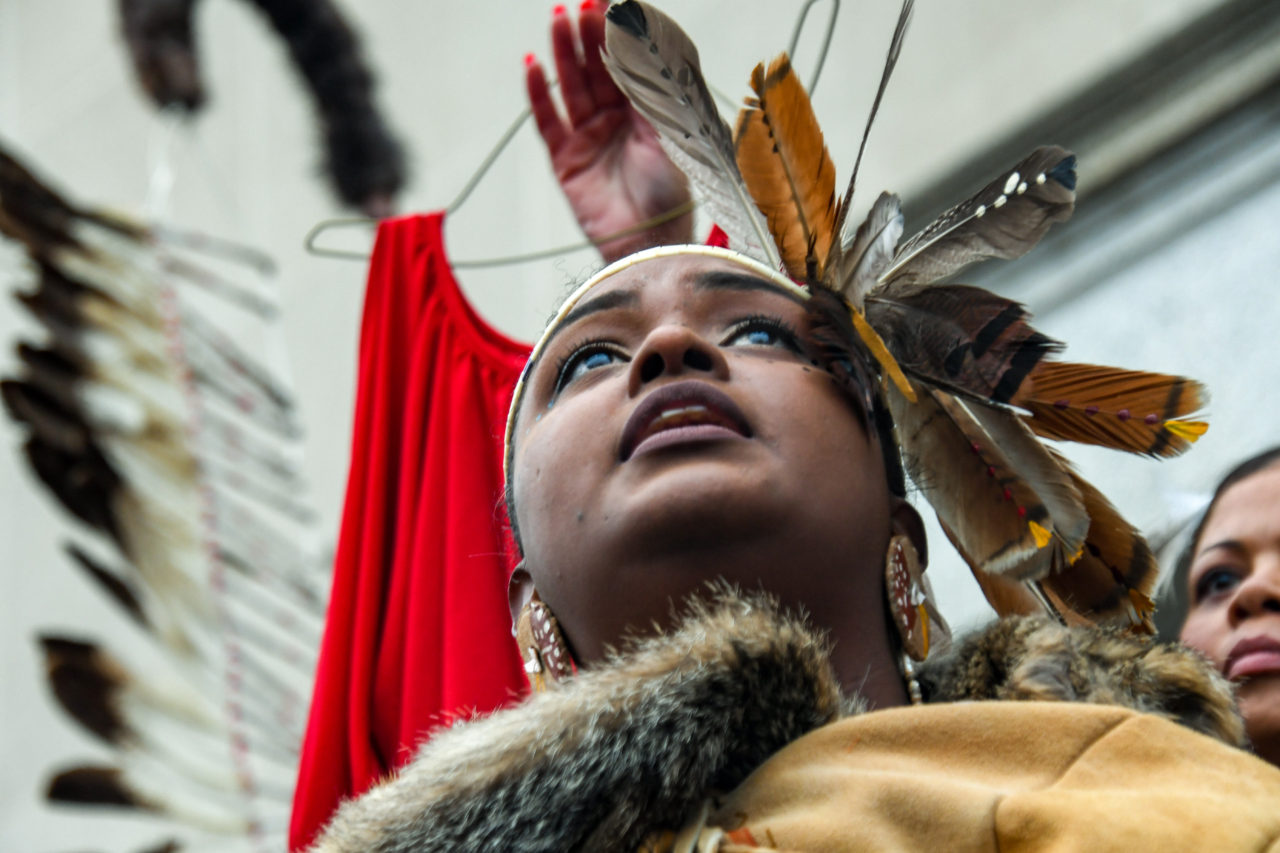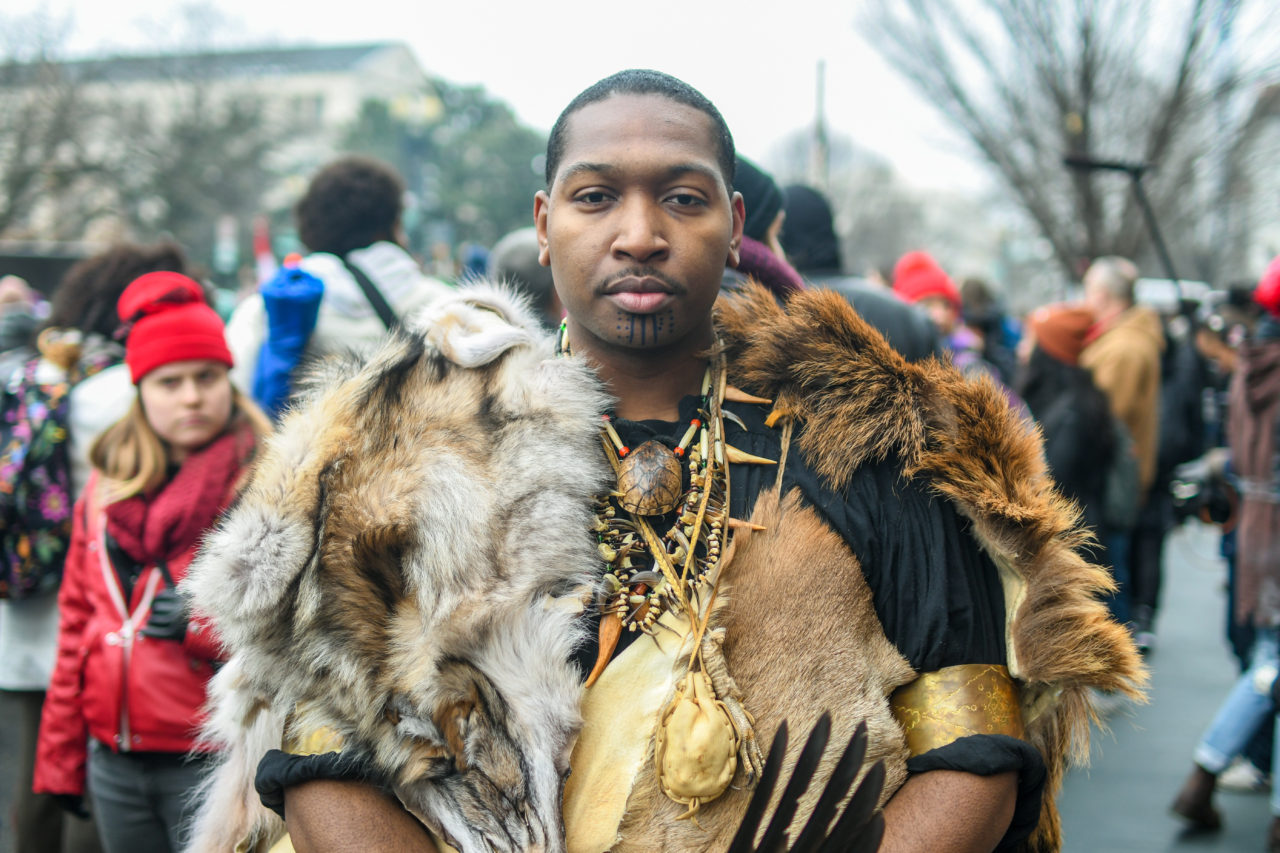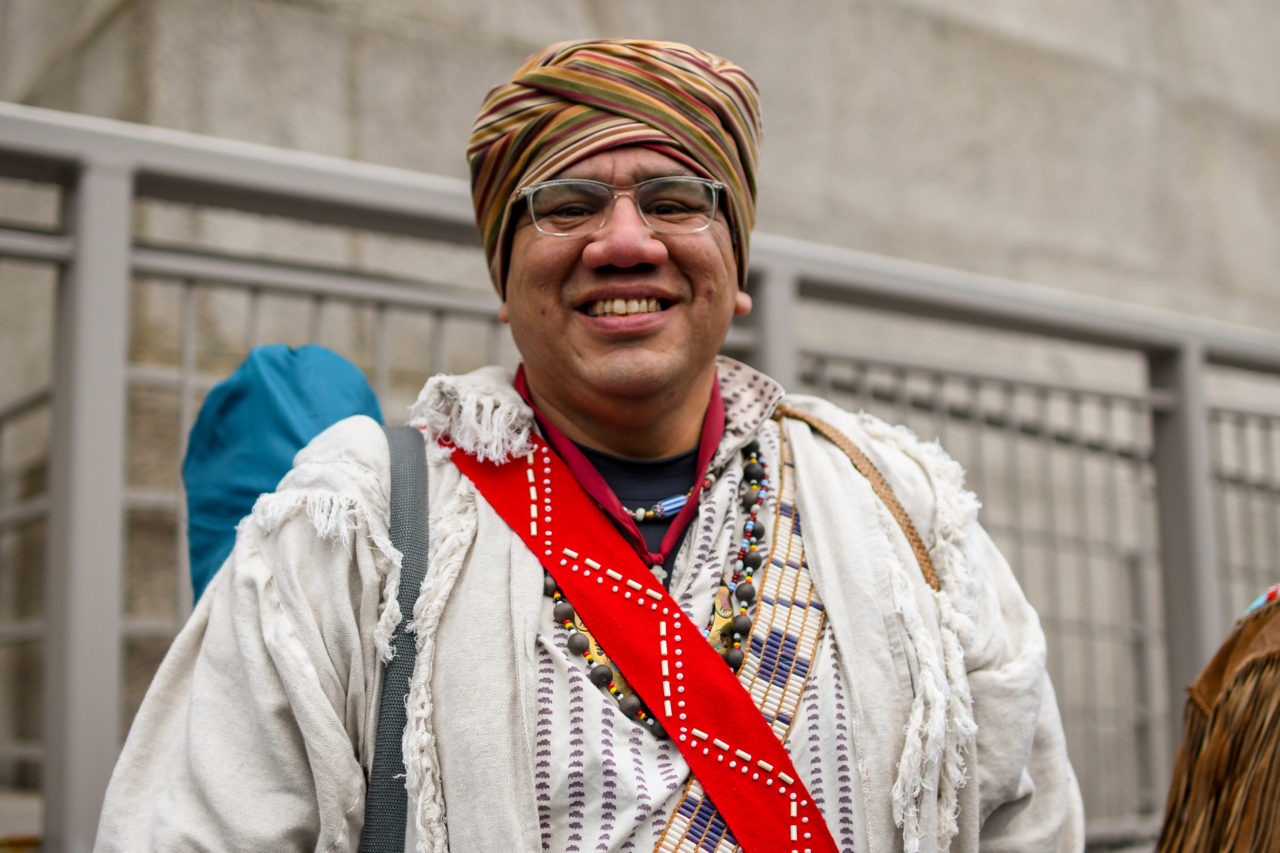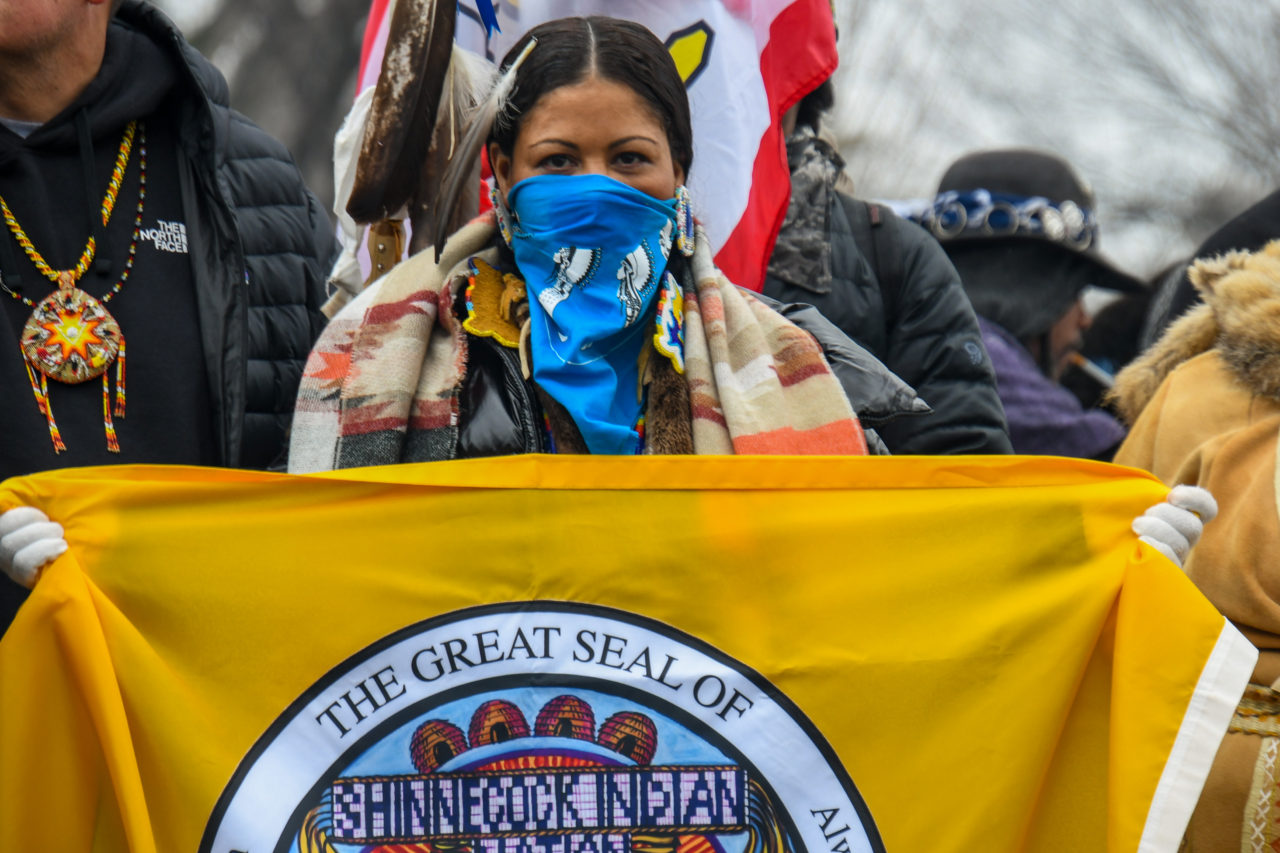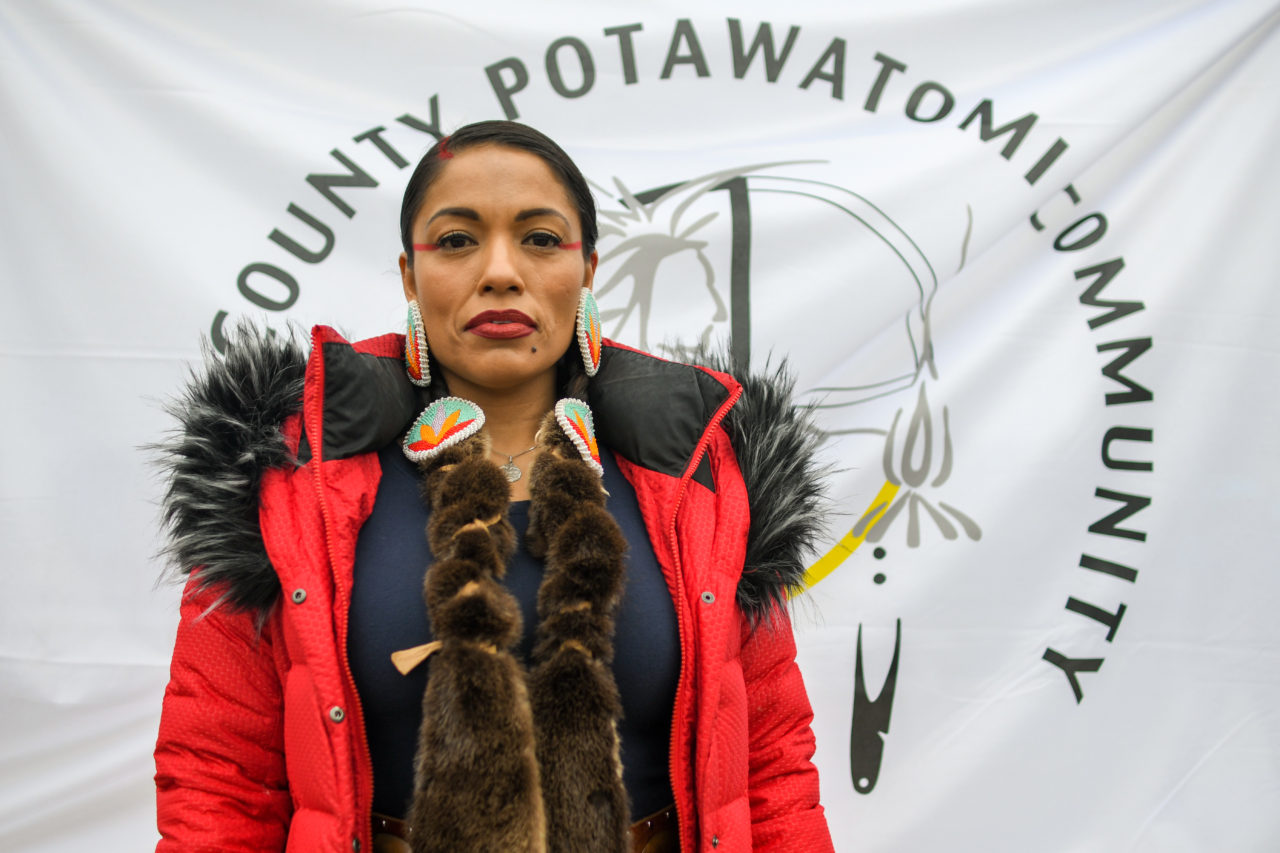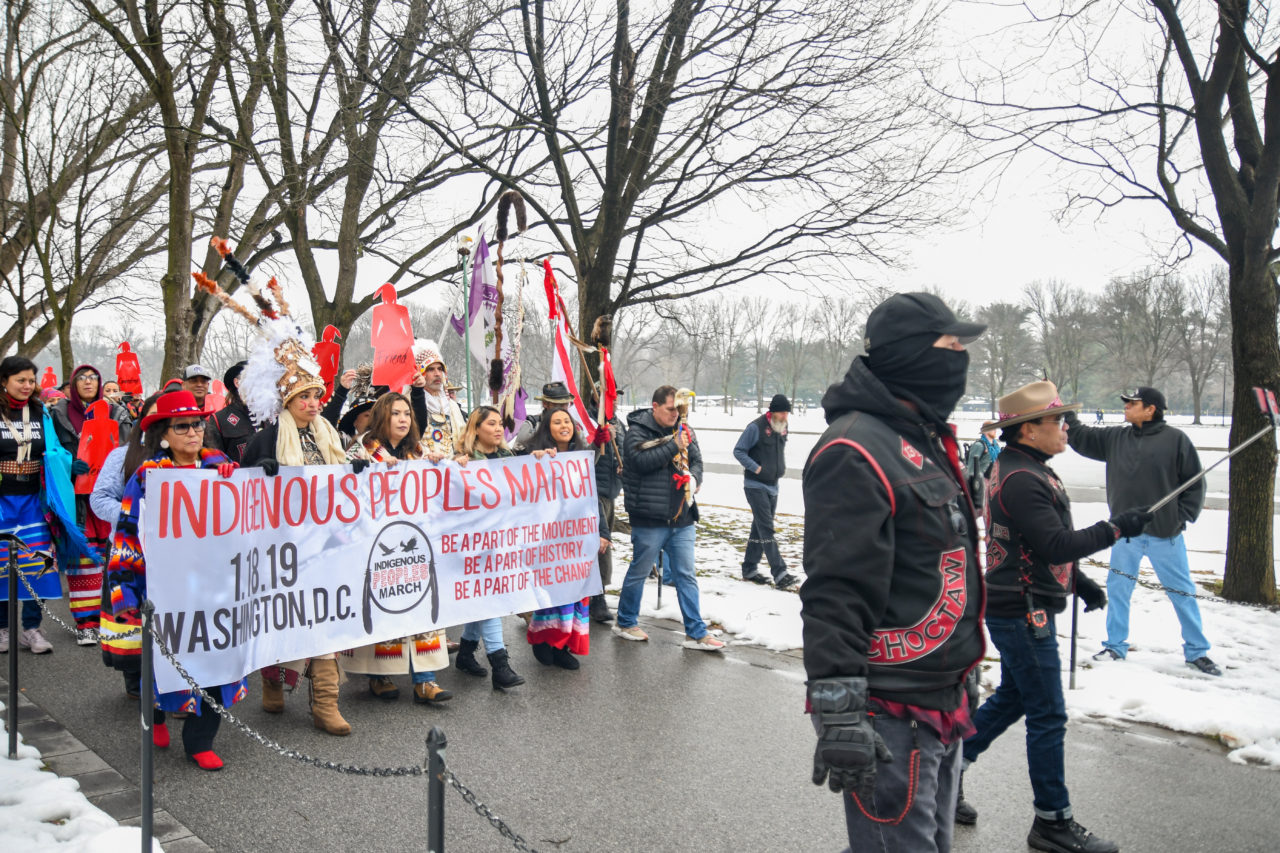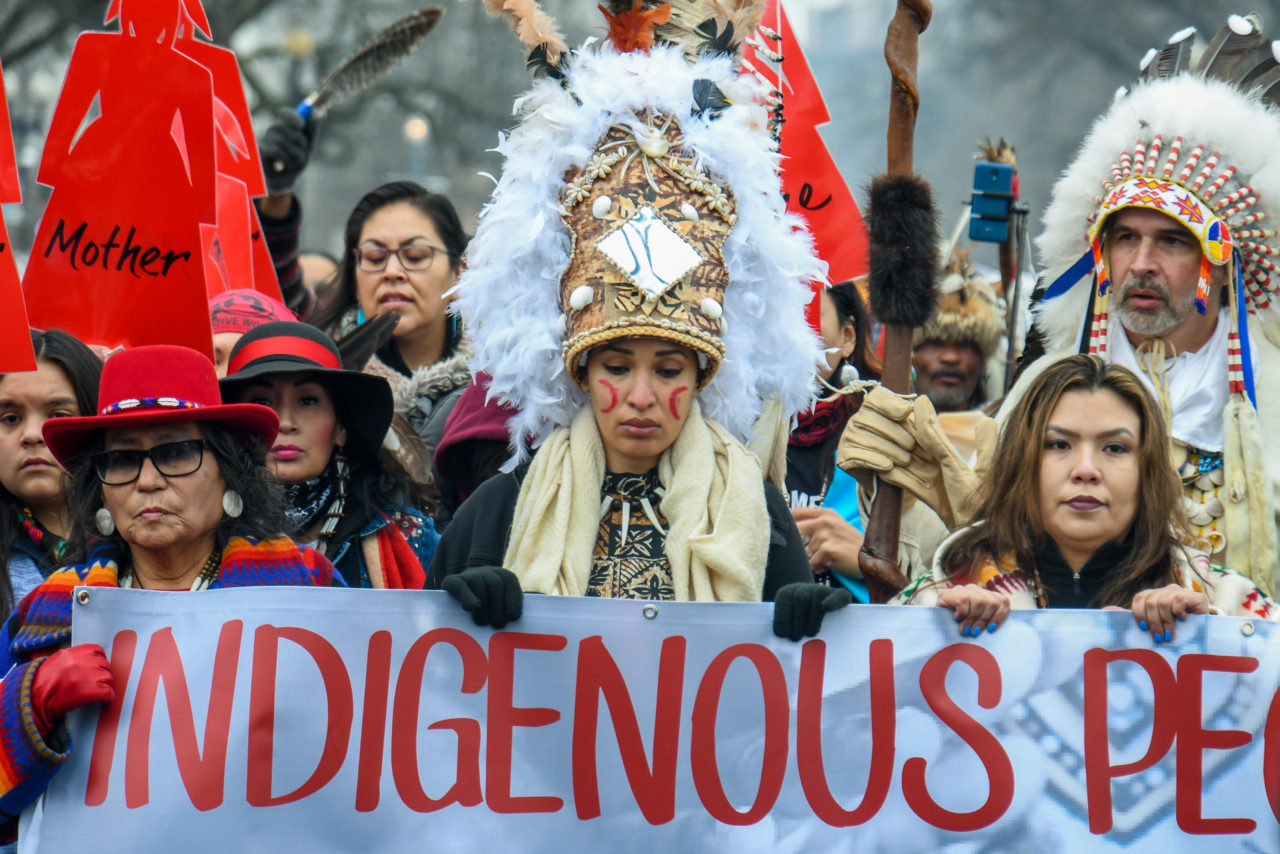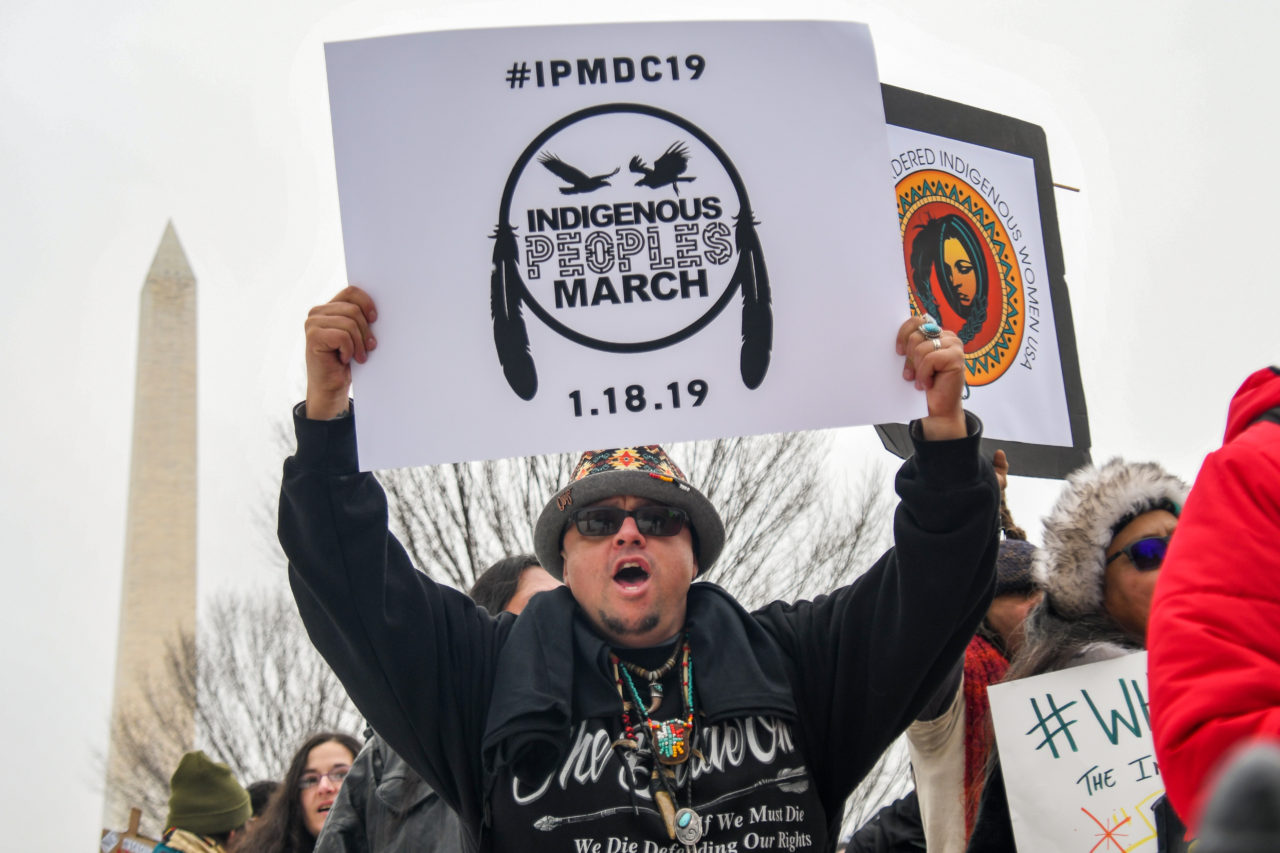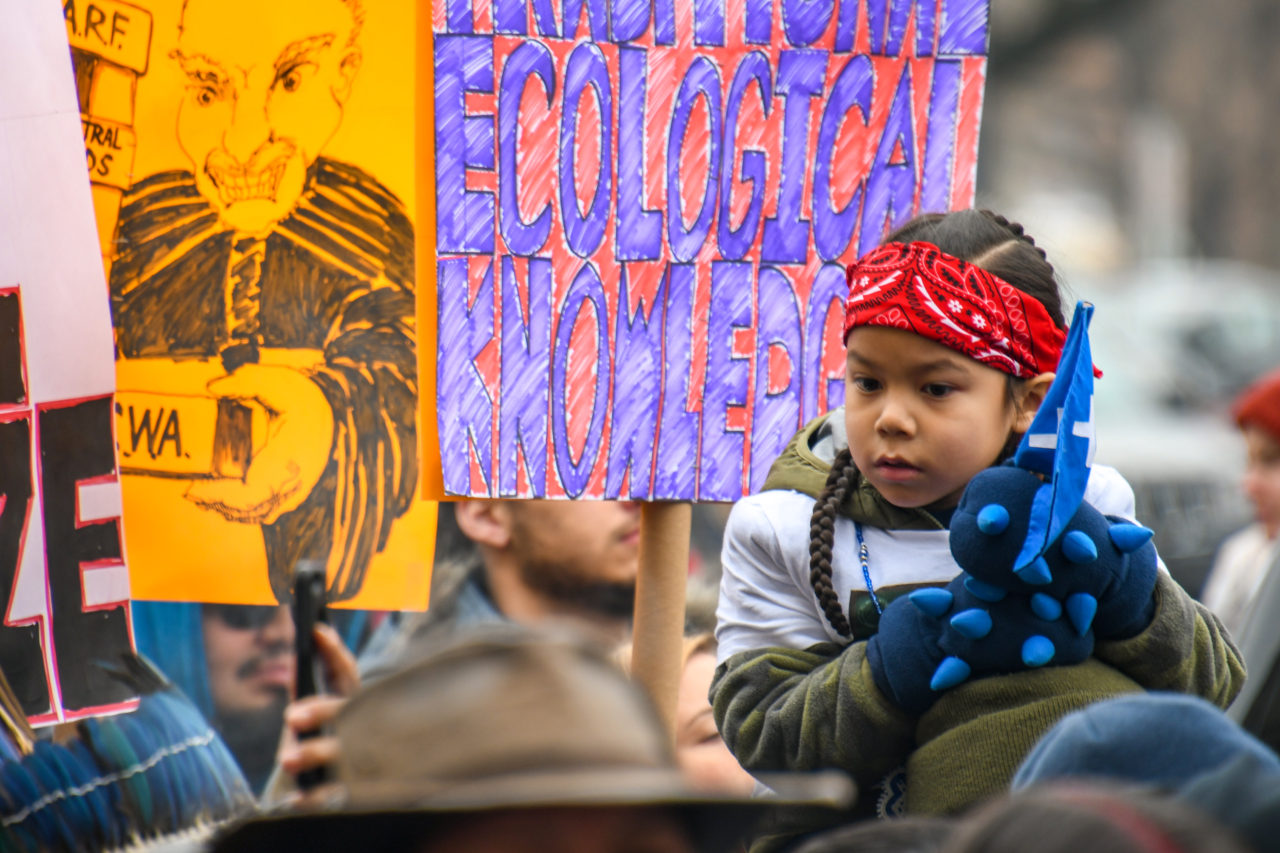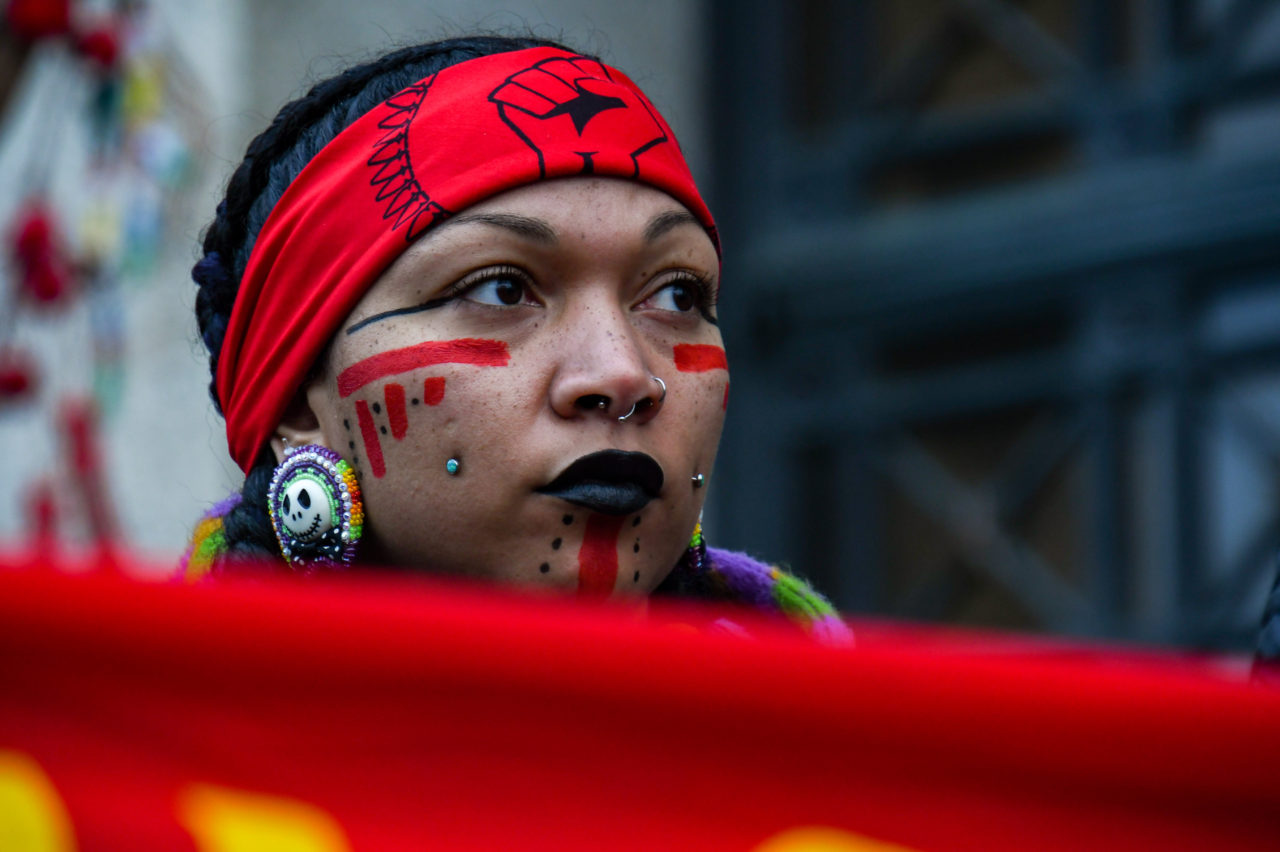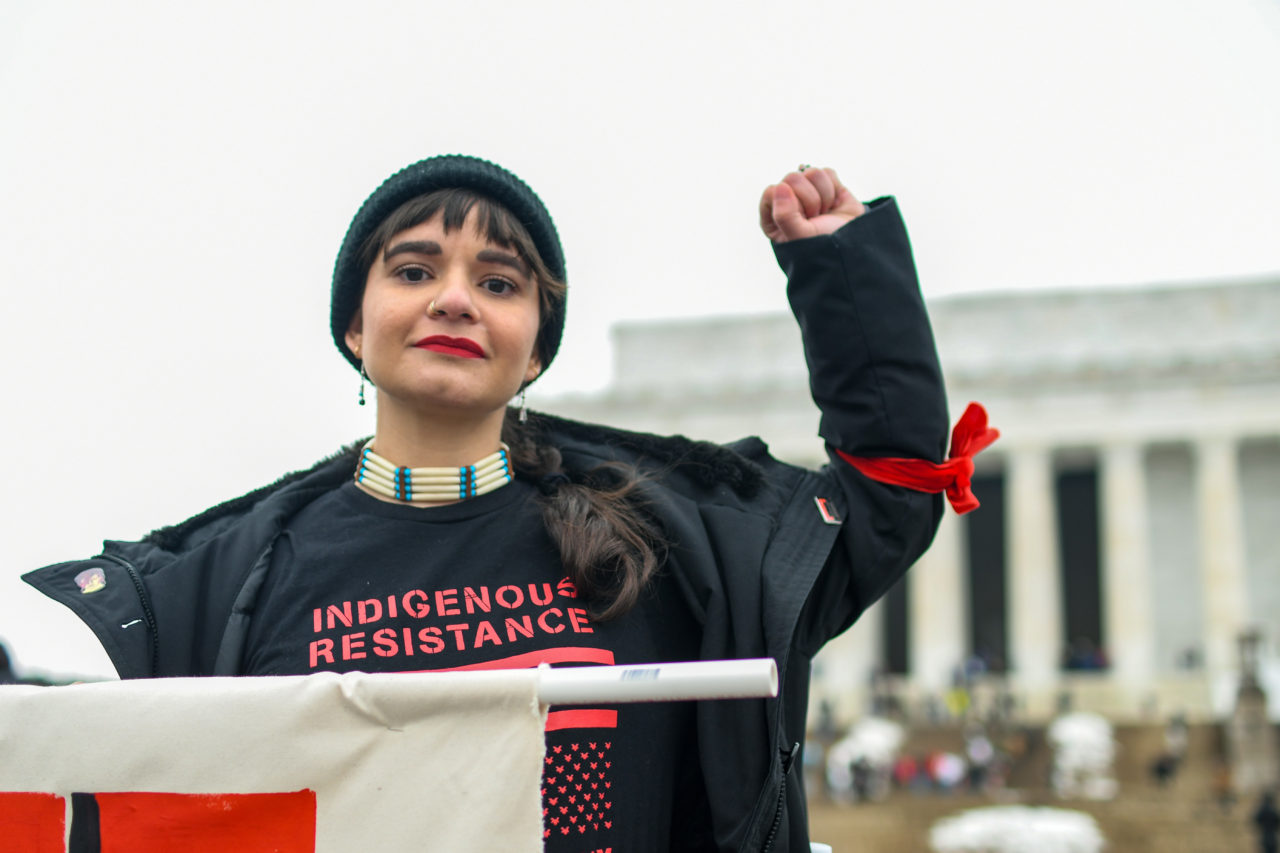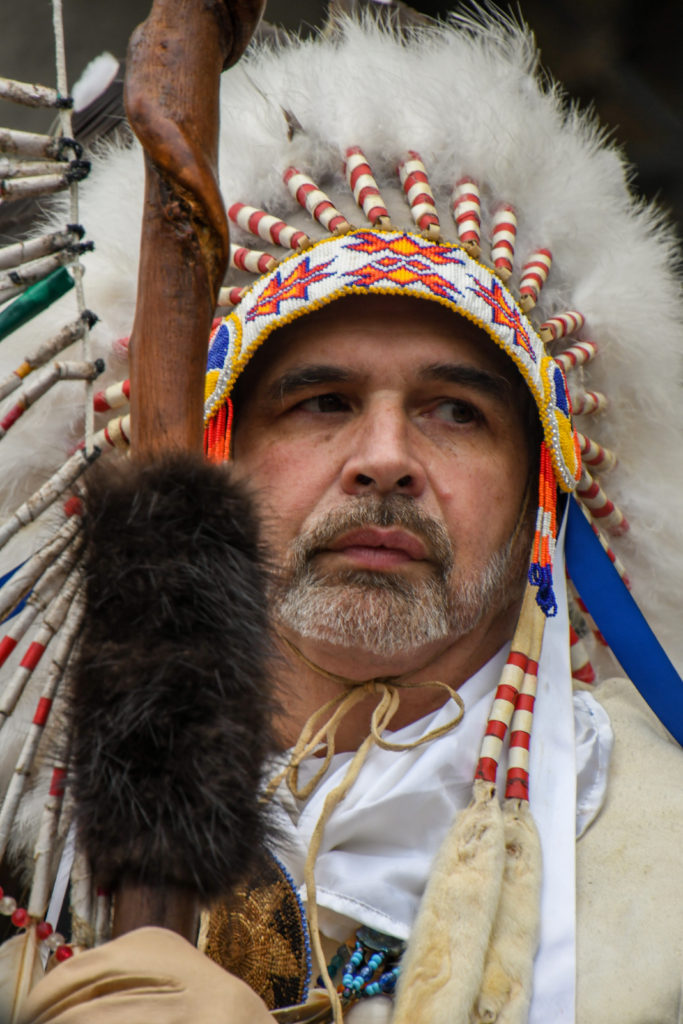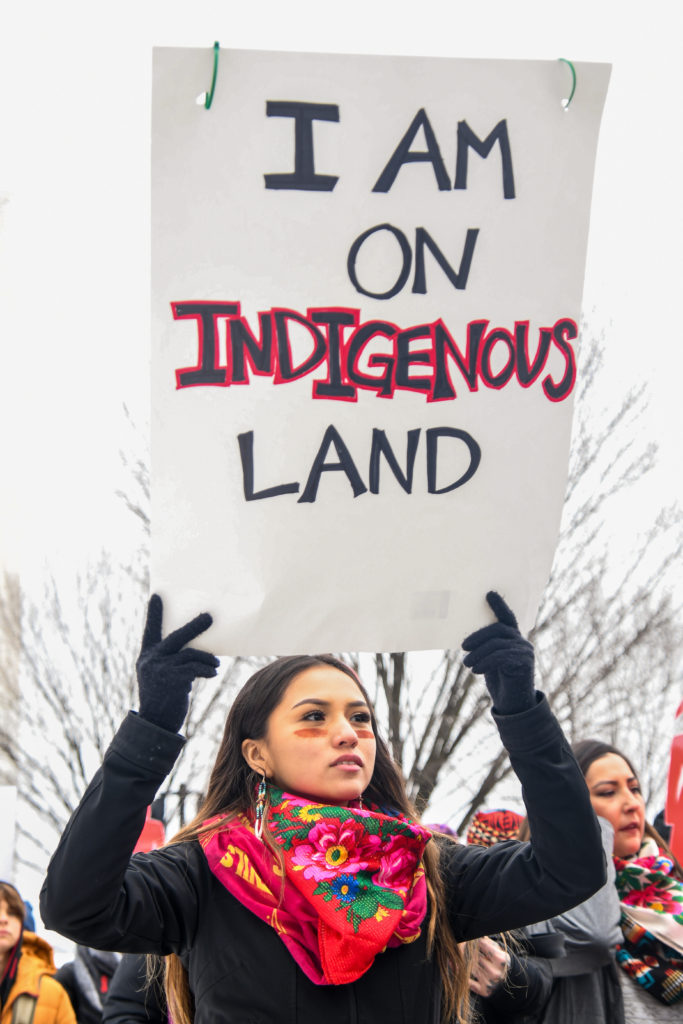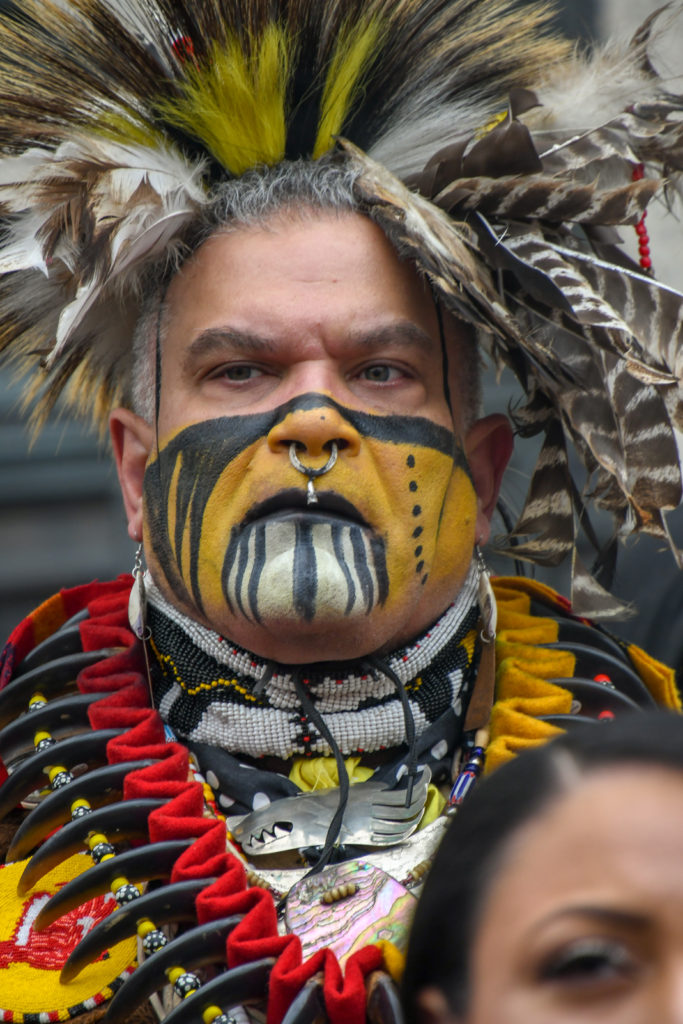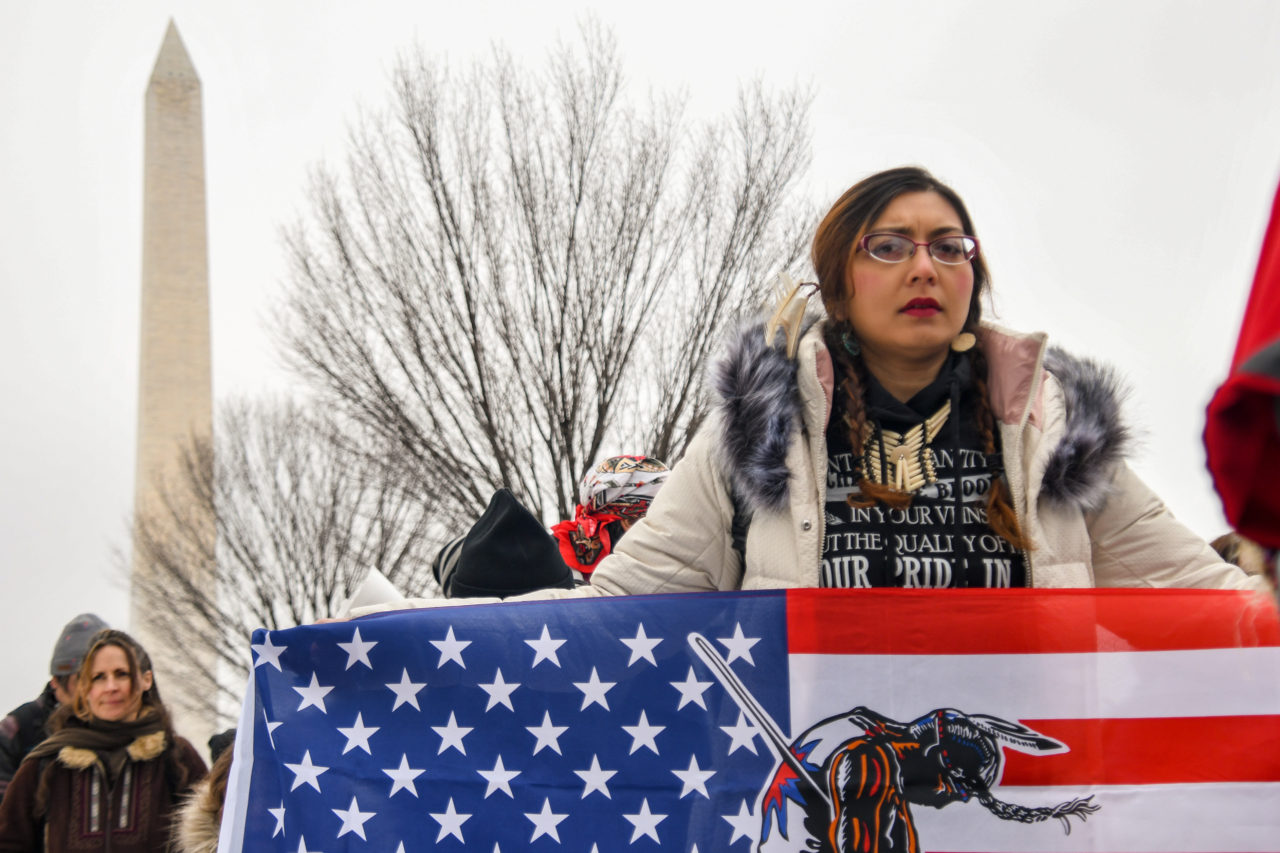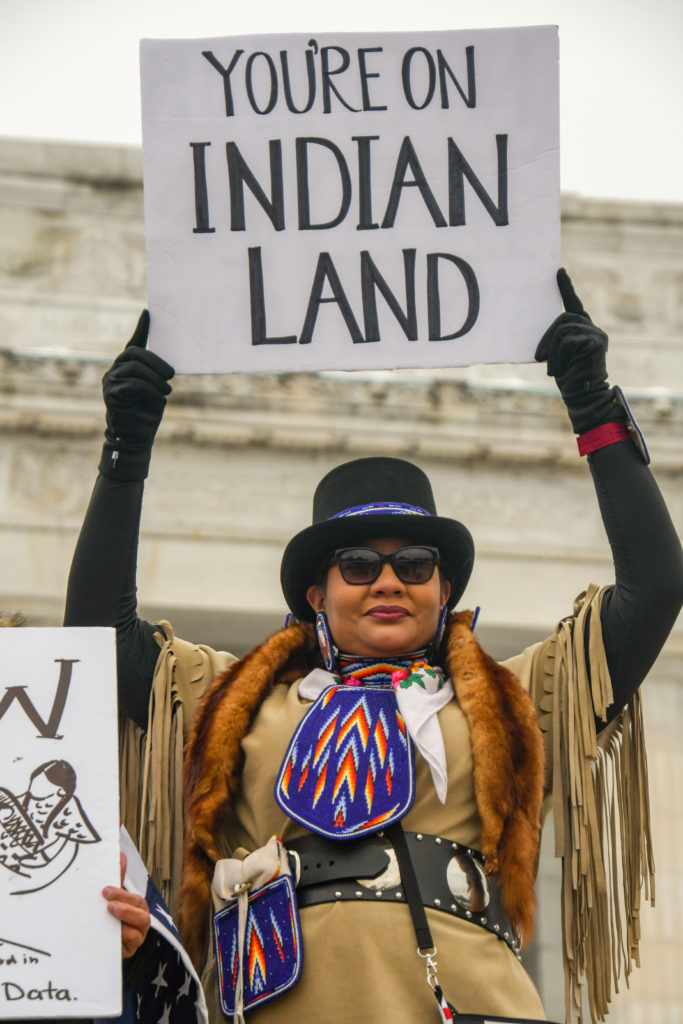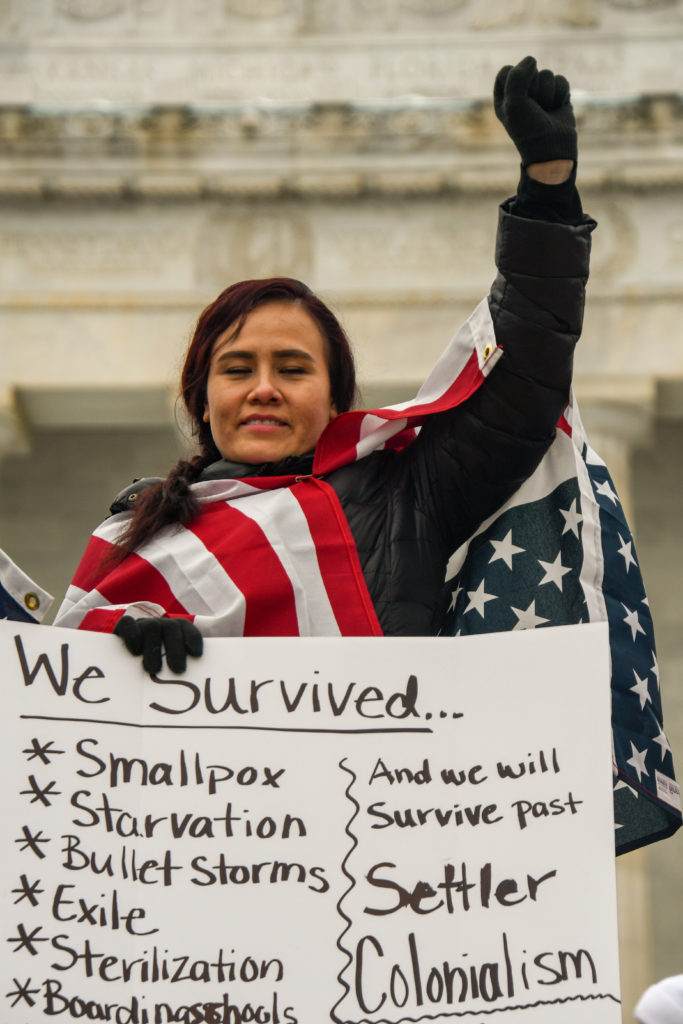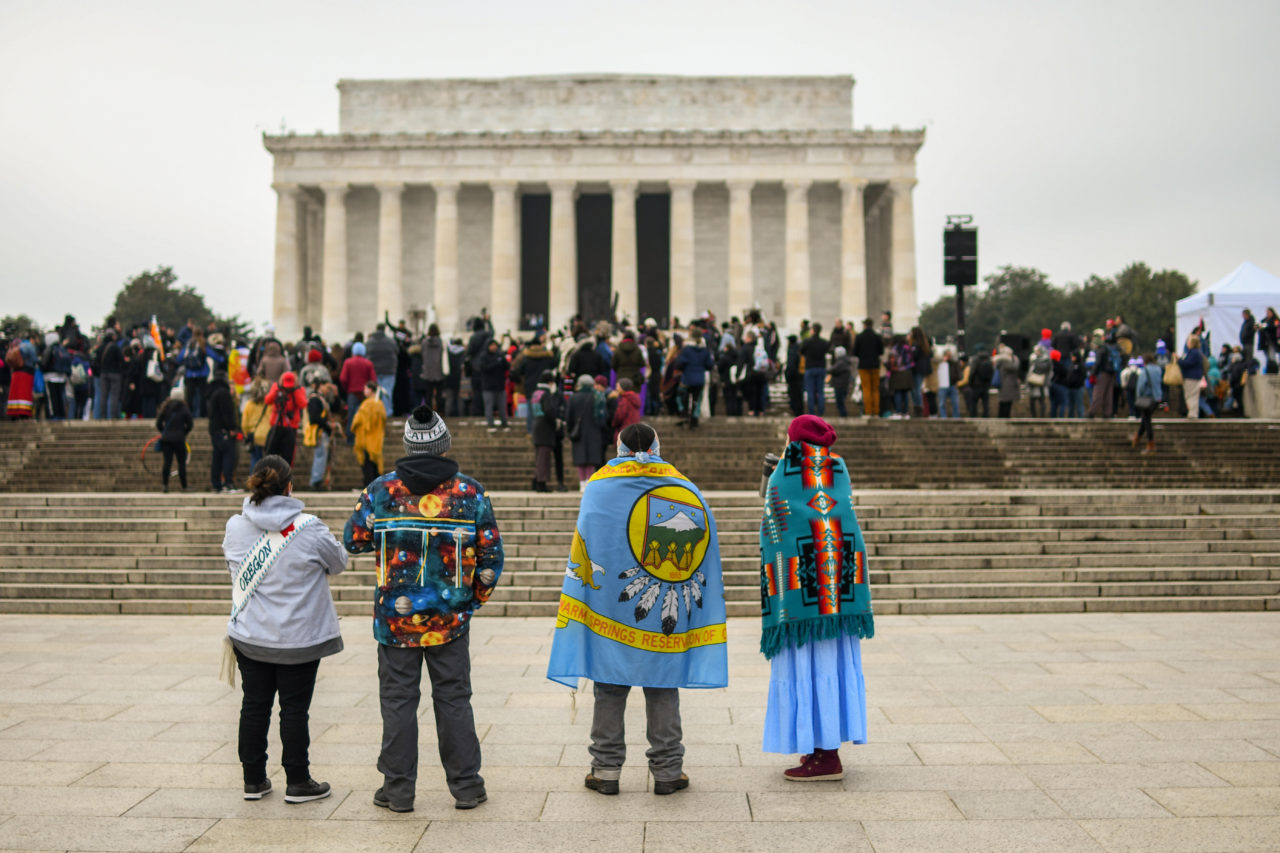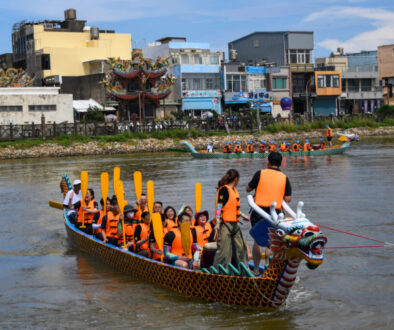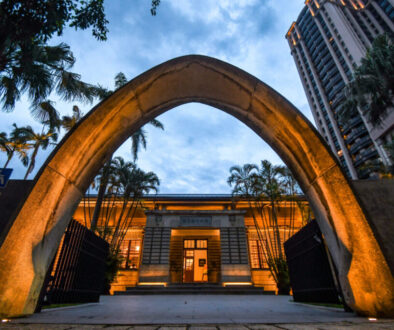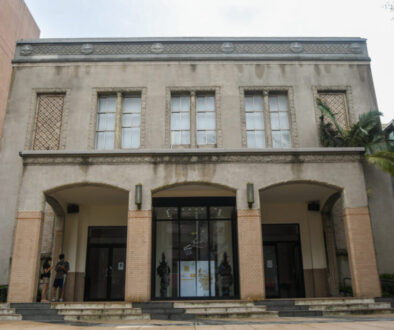Indigenous Peoples March
We Are Still Here
In 1972 members of the American Indian Movement (AIM) stormed the Department of the Interior, which houses the Bureau of Indian Affairs, in a form of protest demanding better housing on reservations and for the federal government to address other indigenous issues.
While AIM’s influence wained due to internal conflicts, a new organization bringing together indigenous people from around the world have gathered again at the steps of the Bureau of Indian Affairs to advocate for clean water, the honoring of treaties, Indigenous women’s safety, and many other pressing topics for Native communities.
The torch of Native rights has been picked up by the Indigenous Peoples Movement. Although young, this group of future tribal leaders, with the guidance of their elders, have organized an event which brought together tribes and nations from around the world with the rallying cry, “We are still here”.
Redrum Bikers Club
The “muscle” at the Indigenous Peoples March was provided by a bikers club known as Redrum. Redum is so much more than just motorcycle enthusiasts, but a group of men who ride for indigenous rights, spreading both positivity and righteousness. While Redrum’s main focus is supporting the First Nations, they have opened up their ranks to all people that wish to support indigenous rights, regardless of their ethnic background.
On the surface, the members of this bikers club may look quite intimidating with their leather jackets and skull patches. In reality, this group of men had nothing but smiles for anyone with questions and were ultimately present to maintain order during the march and keep the peace.
Opening Prayers
Well before the demonstrators took to the streets of Washington, elders and tribal leaders faced the ever-growing crowd in front of the Department of the Interior to engage in prayer. Their prayers took the form of smudging, singing, and music. The religious aspect was a seamless mix of both native religion and Christianity. With their heads bowed the elder led the prayer calling for God to reach out and touch the heart of President Donald Trump so that we would do the right thing for Native people as well as other groups which face discrimination.
After praying to the four directions and making a final plea to God for change, the sound of singing is what reverberated throughout the National Mall. The main topic being addressed by these singers and drummers before breaking into song was water. Past protests and crises such as the Dakota Access Pipeline and Flint, Michigan were cited by speakers but were used as mere examples to support a larger protest to call out government’s blatant disregard to the damage being done to the earth. While the pipeline may be finished and water levels are returning to normal in Flint, there still needs to be more done to both protect Indigenous land and the earth as a whole.
You can read more about Native American’s connection to water here!
Other speakers spoke with both passion and rage with regards to both the march and indigenous rights in America. The most moving was the speech given by two Tainos girls from Puerto Rico. Hurricane Maria ravaged the small American territory located in the Carribean, taking the lives of over 3,000 people. In wake of the hurricane, Puerto Ricans waited desperately for aid but it would never come. President Trump announced not a single dollar will be given to the people of Puerto Rico in fear that the air would be used to pay off the territory’s debt rather than providing for the needy. The young girls held back their tears as they spoke of relatives that had died in the storm and the government which had turned their backs on them.
You can read more about Hurricane Maria and Puerto Rico here or here.
Representatives From All Tribes
Just like the idea behind the inter-tribal powwow, the Indigenous Peoples March brings together members of all tribes to march in solidarity, shining a light on the issues which native people have to face every day. Federally recognized, state recognized, and even unrecognized tribes were all present at the march, from North Carolina’s own unrecognized Woccon to the Eastern Band of Cherokee. Although each individual tribe possesses their own distinct language, culture, and traditions, they come together as one nation to bring about positive change for all indigenous people in the Americas.
You can read more about Native culture in the Carolinas here or here!
Other than just those located immediately on the East Coast, the Indigenous Peoples March attracted native peoples as far as Oregon and the Dakotas. Many of these community leaders are seasoned veterans when it comes to staring down the United States government to promote change.
Reaching back to times as early as the first contact with European explorers, native tribes have been unceasingly subject to racial genocide. Today, many Native people are still struggling to find their identity due to years of displacement and assimilation. Although bloodlines may be thin and traditions lost, the rightful owners of this land are still here. One Cherokee marcher commented that Andrew Jackson compared native tribes to a pie: as long as you keep cutting them up, before too long nothing will be left. The demonstrator just laughed and said, “You can cut it up as much as you like, but there will still be crumbs.”
The March on Washington
The crowd which had converged on the steps of the Department of Internal Affairs made their way to the middle of the street to prepare for the march to Lincoln Memorial. Spirits were high as drums beat like the heart of the people from the center of the mass. The sound of the jingle dancers also brought a sense of home to the protest lines, rousing memories of powwow competitions, friendship, and family.
With the Redrum bikers club leading the way, the Indigenous Peoples March took to the streets. While their route was quite short, they made an impact on all those who happened to be touring the National Mall on that cold January morning. With police escorts clearing the way, marchers with poster boards, smudging sticks, and full regalia drummed, chanted, and sang in the shadow of the Washington Monument.
Why Do I March?
Just glancing through the picket signs held by protesters at the Indigenous Peoples March you will see an array of different cultures and movements all under the umbrella of the Indigenous Peoples Movement. Ethnic groups from Nigeria, Aboriginals from Australia, and even Armenians all marched to draw attention to the plight of their people.
While it may seem a bit of a mess on the surface, they all are causes that any decent person can get behind. Unfortunately, for real change to happen there needs to be a goal such as the bulleted list of demands the AIM had when storming the Department of Internal Affairs.
On the other hand, the Indigenous Peoples March provided an alphabet soup of different organizations and movements which is sure to strike the curiosity of fellow protestors and passerby. Organizations such as the Indigenous Womxn’s Collective, MMIW, and many more would be unknown if it wasn’t for the marchers bringing attention to their causes.
Indigenous Feminism
Among the seasoned veterans and advocators for Indigenous rights were many young women who are the new face for native peoples in America. High profile speakers such as professional boxer Kali Reis and former Mrs. Universe Ashley Callingbull stood up as role models for native women. Other than these women, mothers, sisters, and daughters marched with signs reminding the world that they are the most targeted group in all of America. Pictures of loved ones, dresses, and signs served as a chilling reminder that domestic violence, kidnapping, and assault is a daily struggle which many native women have to live with.
Not all native people are as progressive as those standing with the Indigenous Peoples March in Washington, however. Some tribal members located back at reservations hold more conservative views on other races and LGBTQ rights. While these women still uphold their respect for their elders, they know that a time will come when they will be making more forward-thinking decisions that will ultimately better the lives of indigenous people.
Make America Great
Either by chance or some stroke of political genius, the Indigenous Peoples March was held on the very same day as the March for Life. This demonstration brings many members of conservative America out from their churches, choosing between Trump flags or crosses to take to the streets of DC. Youth groups and congregations from around America were being bussed to the National Mall, being led by either priests or group leaders to take an obligatory picture in front of the Lincoln Memorial before joining the rest of the demonstration converging in front of the capitol.
Well after many of the participants of the Indigenous Peoples March dispersed and went their separate ways, an incident occurred where Vietnam veteran and Native American activist, Nathan Phillips, can be seen drumming in the face of a smirking teen donning a “Make America Great Again” hat. The children surrounded Phillips and a few other marchers left over from the morning, hooted and hollered while the small band of demonstrators continued to drum.
The initial cause of the confrontation was actually caused by a third party of Black Hebrew Israelites who were heckling anyone who happened to cross their path. Phillips claims that in an effort to defuse the situation he began to sing an old AIM song to ease the tension. The Trump supporting children did not know how to react and resorted to mocking the indigenous elder who approached them.
As more and more information has been released, different perspectives of the confrontation have been developed. Some state that Phillips deliberately put himself into the situation to cause controversy while others defend his actions on the basis that he was trying to maintain the peace. Regardless of how you view the situation, there is no doubt that the children acted boorishly with lack of respect for Mr. Phillips and his culture. Political motive or not, the reaction of the Trump supporters were natural and further proved the racial divide in the United States.
Form your own opinion on the situation and watch the video here or read about it here!
Grassroots
While the controversy may bring attention to the movement, we can not forget the people who marched for their tribes, their families, and their ancestors. The Indigenous Peoples Movement has just taken the first step to possibly being the forerunner for advocating native rights in the Americas. For the women who have gone missing, the land which has been taken, culture which has been stripped, language which has been replaced, and water which has been tainted, Indigenous people will shake the foundations of the earth and cry out “We are still here”
The Indigenous Peoples Movement now has finally had the cameras turned on them. It is the hope of all people that support native rights that they will continue to strive for truth and justice for all indigenous people.

